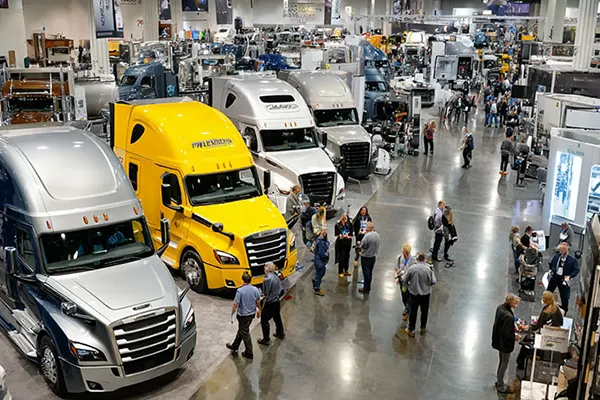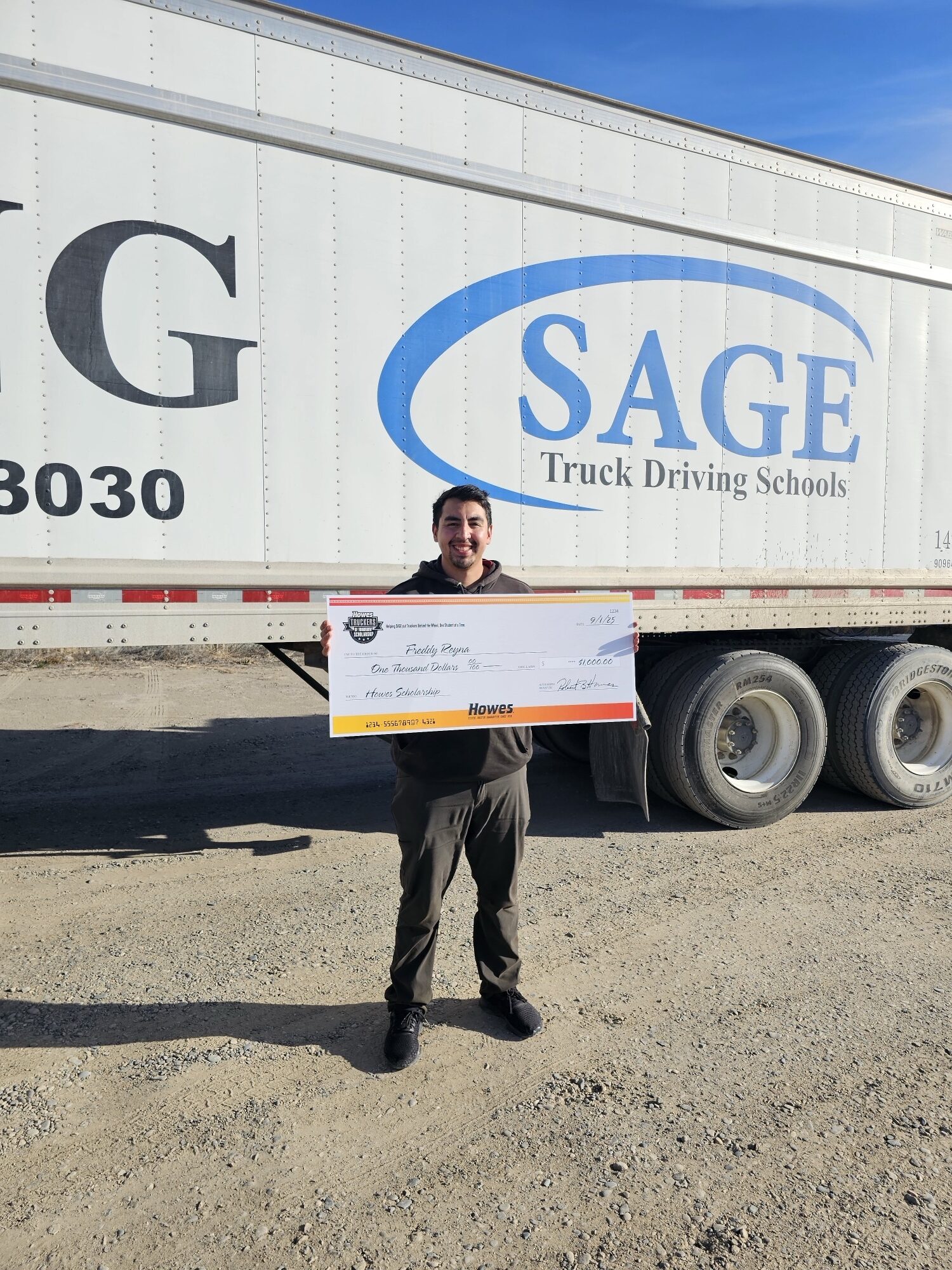
Top Trucking Conferences and Trade Shows to Attend This Year 2025
Top Trucking Conferences and Trade Shows to Attend This Year
In a fast-evolving industry like trucking, staying informed isn’t just beneficial — it’s essential. Trucking conferences and trade shows are where industry leaders, innovators, and decision-makers converge to share ideas, showcase technology, and shape the future of transportation. These events bring together fleets, freight brokers, OEMs, technology providers, and regulators, offering a unique space for learning, networking, and strategic growth.
Whether you’re an owner-operator, a fleet manager, or part of a logistics startup, attending the right events can sharpen your competitive edge. From cutting-edge demonstrations of electric and autonomous trucks to deep dives into compliance, ELD mandates, and fuel efficiency trends, these gatherings serve as launchpads for new opportunities and insights.
In this guide, we’ll spotlight the top national conferences every trucking professional should know about, while also uncovering hidden gems — smaller, specialized events delivering outsized value.
Why Attending Trucking Conferences Matters
In a landscape shaped by regulatory changes, fuel price volatility, and technological disruption, trucking conferences offer more than just professional development — they provide a strategic advantage. Let’s look deeper into why they matter.
Build High-Value Industry Connections
One of the most powerful aspects of these events is access. Whether you’re a small carrier looking to expand partnerships or a fleet executive exploring joint ventures, conferences gather a who’s who of the industry.
- Network with key players: shippers, brokers, tech vendors, regulators, and fellow operators.
- Attend structured matchmaking sessions or informal networking mixers.
- Learn what’s working (and what’s not) directly from peers.
Pro Tip: Don’t just collect business cards — set follow-up reminders post-event to deepen the relationship.
Stay Ahead of Tech and Regulatory Shifts
With the pace of innovation, missing one major show could mean falling six months behind. Conferences are where:
- OEMs unveil new electric and autonomous trucks (e.g., Daimler, Nikola, Tesla Semi).
- Compliance experts walk through the latest FMCSA or DOT updates.
- Tech firms debut real-time telematics platforms, route optimization AI, or driver safety dashboards.
You’ll get to ask questions, compare solutions side by side, and see how innovations impact the real world.
Turn Insight into Action for Your Business
What separates conferences from online learning is the opportunity to see solutions in action:
- Experience hands-on demos of new hardware, software, and fleet equipment.
- Participate in maintenance or operations workshops that tackle common pain points.
- Hear real-world case studies from successful fleets.
By absorbing this information directly from trusted sources — often subject matter experts or top-performing operators — you gain practical, ready-to-apply insights for your business.
Top National Trucking Conferences in 2025
Each year, a few standout events define where the trucking industry is headed. These national conferences bring together thousands of professionals to share knowledge, unveil technology, and tackle the industry’s biggest challenges. If you’re planning your 2025 calendar, these events should be at the top of your list.
What are the top trucking trade shows in 2025?
The top trucking trade shows in 2025 include MATS, TMC Annual, and ATA Management Conference, offering expert panels, exhibits, and networking opportunities.
Mid-America Trucking Show (MATS)
Location: Louisville, KY
Dates: March 27–29, 2025
Best for: Owner-operators, drivers, small fleets, suppliers
MATS is the largest trucking trade show in North America, drawing more than 70,000 attendees and over 1,000 exhibitors. This event is known for its hands-on experience with the latest trucks, parts, and in-cab technologies.
What to expect:
- Live product demonstrations from leading manufacturers such as Kenworth, Peterbilt, and Freightliner.
- A massive exhibit floor featuring aftermarket parts, tools, and services.
- Career and recruitment booths connecting drivers with hiring carriers.
- Nightly entertainment and networking events designed to foster real connections.
This event is especially valuable for smaller operations and independent drivers looking for practical solutions and vendor relationships.
TMC Annual Meeting & Transportation Technology Exhibition
Location: Orlando, FL
Dates: February 24–27, 2025
Best for: Fleet maintenance teams, engineers, operations managers
Organized by the American Trucking Associations’ Technology & Maintenance Council, this conference focuses on vehicle technology, diagnostics, and predictive maintenance. It’s where maintenance standards and best practices are often born.
What to expect:
- Technical sessions covering telematics, electric powertrains, and cybersecurity.
- Access to TMC’s Recommended Practices for fleet performance and safety.
- In-depth training opportunities and interactive equipment demos.
- Expert panels discussing how emerging tech impacts fleet maintenance strategy.
This is the go-to conference for professionals serious about fleet performance, uptime, and compliance.
ATA Management Conference & Exhibition (MCE)
Location: Austin, TX
Dates: October 2025 (exact dates to be announced)
Best for: Executives, policy influencers, business strategists
MCE is ATA’s flagship leadership conference, bringing together top-level decision-makers across the freight, logistics, and carrier landscape. The event centers on business strategy, federal policy, and the macroeconomic outlook for the industry.
What to expect:
- High-level discussions with government regulators and policy analysts.
- Forecasting sessions on freight demand, insurance, and supply chain volatility.
- Private networking events designed for senior leaders and business development.
- A curated exhibit floor focused on fleet technology, insurance, finance, and legal services.
If you’re involved in strategic planning, regulatory affairs, or long-term business growth, this conference is essential.
Underrated Conferences Worth Your Time
Not every impactful event makes headlines. Some of the most valuable trucking conferences are smaller, more specialized gatherings where deep learning, niche topics, and meaningful connections thrive. These hidden gems are ideal for professionals looking to sharpen their competitive edge without the crowds.
Accelerate! Conference & Expo by Women in Trucking Association
Location: Dallas, TX
Dates: November 10–13, 2025
Best for: Women professionals, diversity advocates, HR leaders, logistics executives
This conference is hosted by the Women in Trucking Association and focuses on gender diversity, leadership, and career advancement in the trucking and transportation sectors. While open to all, it specifically champions the advancement of women in an industry where female representation remains under 15%.
What to expect:
- Sessions on recruiting, retaining, and promoting women in transportation roles.
- Executive leadership panels featuring successful women in fleet and logistics.
- Networking events that prioritize mentorship and professional development.
- Workshops on workplace culture, safety, and technology adaptation.
This is more than a conference — it’s a movement toward building a more inclusive industry.
National Association of Small Trucking Companies (NASTC) Annual Conference
Location: Nashville, TN
Dates: November 2025 (exact dates TBD)
Best for: Small fleet owners, independent carriers, startup trucking firms
NASTC’s annual gathering offers a tailored experience for small to mid-sized fleets, which often face unique challenges compared to larger carriers. The sessions are practical, and the audience is highly engaged, making this one of the most business-savvy events on the calendar.
What to expect:
- Seminars on cost control, driver retention, and FMCSA compliance.
- Legal and insurance updates specific to small carriers.
- Operational workshops for ELD management, IFTA reporting, and safety audits.
- An exhibit floor curated for cost-effective services and tools.
This conference delivers highly relevant takeaways that attendees can immediately apply to improve margins and operations.
Truckload Carriers Association (TCA) Annual Convention
Location: Phoenix, AZ
Dates: March 2025 (exact dates TBD)
Best for: Truckload carriers, executives, operations teams
Focused exclusively on the truckload segment, this event brings together companies that move full trailer loads to discuss issues like capacity, driver shortages, and freight rates. The TCA convention is known for its tight-knit community and solutions-oriented sessions.
What to expect:
- Strategic talks on truckload economics, driver engagement, and digital freight.
- Executive panels featuring leaders from major truckload carriers.
- Recognition of safety, service, and performance excellence in the sector.
- Legislative insights into regulations that impact for-hire fleets.
For companies operating in the truckload space, this is one of the most targeted and actionable events available.
How to Choose the Right Conference for Your Goals
With dozens of trucking conferences available each year, attending every event simply isn’t realistic — or necessary. The key is choosing the ones that align with your specific business needs, role, and long-term goals. Here’s how to make the right decision.
Start with Your Primary Objective
Before registering, ask yourself: What do I want to walk away with?
- If your goal is tech adoption, look for events with strong vendor exhibits and product demos (e.g., TMC Annual or MATS).
- If you’re focused on leadership or policy, opt for C-level events like the ATA Management Conference.
- If you run a small fleet, prioritize business-focused gatherings like NASTC or regional trucking association meetings.
- If you’re building your career, Accelerate! or industry-specific workshops offer targeted professional development.
Your purpose should guide every choice, from which sessions you attend to who you network with.
Evaluate Your Budget and Bandwidth
Conferences vary significantly in cost and time commitment. Keep in mind:
- Larger expos often involve airfare, hotels, and multi-day agendas.
- Regional or niche events may offer more focused learning at a lower cost.
- Many events now offer virtual passes, letting you participate without travel. These can be ideal for remote team members or busy owner-operators.
Consider total return on investment — not just the ticket price.
Review the Agenda Before Committing
Not all events with the word “trucking” in the title will be relevant to your role. Take time to review:
- Speakers and sessions: Are they credible, relevant, and practical?
- Workshops and breakouts: Will you walk away with skills you can apply?
- Exhibitors and sponsors: Do they align with your current or future vendor needs?
Choose events that offer content you can immediately act on — not just theory.
Ask Colleagues and Industry Peers
One of the most reliable ways to vet a conference is through word of mouth. Ask:
- What value did others get from past events?
- Did they make useful connections or find new vendors?
- Was the content insightful or just promotional?
Insights from people who’ve attended before can help you avoid wasting time or money on the wrong event.
Upcoming Trucking Conference Calendar Snapshot
If you’re short on time and want a quick overview of the year ahead, this calendar highlights the most relevant trucking events in 2025. Use it to plan your travel, budget, and professional development.
Tip: Dates may shift slightly, so be sure to confirm details on each event’s official website before making travel plans.
Frequently Asked Questions
1. Are trucking trade shows open to the public?
Some trucking shows, like the Mid-America Trucking Show (MATS), are open to the public and welcome drivers, vendors, and enthusiasts. Others, such as ATA’s MCE or TMC Annual, are typically industry-only and require registration.
2. What should I bring to a trucking conference?
Bring business cards, a notebook or digital device for taking notes, and comfortable shoes. If you’re networking or job-seeking, have a clear elevator pitch and updated contact info ready.
3. Can I earn continuing education credits at these events?
Yes, many conferences — especially those hosted by associations like ATA or TMC — offer CE credits or certifications related to safety, compliance, or technical training. Check the agenda or ask organizers in advance.
4. How can I find smaller or regional trucking events near me?
Visit your state or regional trucking association’s website (e.g., Texas Trucking Association, California Trucking Association, etc.). They regularly host localized conferences, training seminars, and networking events tailored to your area.
Improving Communication Between Truck Drivers and Dispatchers with Modern Tools
Why Communication Between Drivers and Dispatchers Matters
What is driver-dispatcher communication?
Driver-dispatcher communication is the real-time, bidirectional flow of information between commercial drivers and dispatchers. This includes updates on delivery status, changes in routing, equipment issues, traffic delays, and safety concerns. It serves as the central nervous system of any fleet operation.
Why It’s Critical
Effective communication ensures:
- Operational efficiency ¾ Faster, smarter routing reduces idle time and optimizes resource allocation.
- Driver safety ¾ Immediate updates on road conditions or mechanical issues help prevent accidents.
- Customer satisfaction ¾ Clear ETAs and proactive notifications create transparency and trust.
A 2024 survey by FleetOwner showed that companies with integrated communication platforms experienced 23% fewer missed deliveries compared to those using traditional methods.
Consequences of Poor Communication
When communication breaks down, the ripple effects can be costly:
- Delayed or failed deliveries.
- Increased fuel consumption from inefficient routing.
- Frustrated drivers and dispatchers due to unclear expectations.
- Compromised safety from unreported vehicle issues or last-minute route changes.
Even minor miscommunications can result in lost revenue, regulatory penalties, and diminished brand reputation.
Industries That Rely Heavily on This Communication
This isn’t just a trucking issue. The need for precise, timely communication spans multiple industries:
- Logistics and freight: Real-time tracking and coordination are mission-critical.
- E-commerce and delivery services: High-volume, time-sensitive deliveries require agile dispatching.
- Construction fleets: Equipment deliveries must align precisely with project timelines.
- Field service operations: Technicians and contractors depend on accurate job details and updates.
Top Communication Challenges in Traditional Dispatching
While communication is vital to fleet operations, many companies still rely on outdated, fragmented systems that fail to support the demands of real-time logistics. These legacy methods often create inefficiencies, increase risk, and undermine operational goals.
1. Outdated Communication Methods
Many fleets continue to depend on phone calls, CB radios, or even handwritten notes. These methods lack the clarity and traceability needed for effective coordination.
- Information can be misheard, forgotten, or relayed inaccurately.
- There’s no written record of what was communicated or when.
- Real-time updates are difficult to capture or distribute consistently.
For example, if a dispatcher gives a driver a new delivery address over the phone and the driver miswrites it, the result could be a costly delivery error.
2. Lack of Real-Time Visibility
When dispatchers cannot see where drivers are or what obstacles they’re facing, they’re left guessing.
- Delays caused by traffic, construction, or vehicle issues go unreported until it’s too late.
- Dispatchers are forced to react rather than plan proactively.
- Route changes or job updates may not reach drivers in time.
This lack of situational awareness contributes to inefficiencies and misalignment between field and office operations.
3. Communication Silos Across Systems
In many operations, communication happens across disconnected tools: a routing system here, a messaging app there, and manual logs somewhere else.
- Information is scattered, inconsistent, and often incomplete.
- Dispatchers and drivers waste time jumping between platforms.
- Important updates can be delayed or missed entirely.
These silos create friction in daily workflows and limit opportunities for optimization.
4. No Communication Traceability
Traditional methods don’t capture or store messages in a way that can be audited or reviewed later.
- There is no central communication log.
- If a conflict or compliance issue arises, there’s no way to verify who said what or when.
- This lack of accountability can lead to misunderstandings and disputes, both internally and with customers.
5. Difficulty Prioritizing Urgent Information
Without a clear system for categorizing or flagging messages, dispatchers and drivers may struggle to identify what needs immediate attention.
- Critical updates may be buried in routine chatter.
- Drivers might miss safety instructions or high-priority changes due to information overload.
- Dispatchers must spend extra time repeating or clarifying messages.
Over time, this can erode trust and increase the risk of costly mistakes.
Modern Tools That Bridge the Communication Gap
Modern fleet operations demand tools that offer speed, traceability, integration, and ease of use. Today’s technologies are built not just to send messages, but to support smarter, safer, and more efficient decision-making between drivers and dispatchers.
Below are the leading communication tools that address the limitations of traditional systems.
1. GPS Fleet Tracking Systems
What it is:
GPS fleet tracking systems monitor vehicle locations in real time and feed that data back to dispatchers through a centralized platform.
How it helps:
- Offers instant visibility into driver location and movement.
- Allows dispatchers to provide accurate ETAs and respond to delays proactively.
- Enables route optimization based on traffic, weather, or road conditions.
Example tools: Verizon Connect, Samsara, Geotab
GPS fleet tracking provides real-time location data to help dispatchers manage routes and communicate effectively with drivers.
2. Mobile Dispatching Apps
What it is:
These apps allow dispatchers to assign jobs, share instructions, and communicate with drivers directly through mobile devices.
How it helps:
- Replaces phone calls and paper instructions with clear, logged digital communication.
- Enables two-way messaging with read receipts.
- Streamlines job scheduling, proof of delivery, and status updates.
Example tools: Motive (formerly KeepTruckin), Fleet Complete, Trucker Tools
Why it matters: Drivers receive updates on the go, reducing delays and misunderstandings while keeping their focus on the road.
3. ELDs and Telematics Platforms
What it is:
Electronic Logging Devices (ELDs) and telematics platforms automatically record vehicle activity, driver hours, engine diagnostics, and safety data.
How it helps:
- Eliminates manual logging and reduces reporting errors.
- Flags mechanical issues early, enabling proactive maintenance coordination.
- Supports compliance with DOT regulations and internal safety standards.
Example tools: Omnitracs, Zonar, JJ Keller
This type of automation reduces the back and forth between drivers and dispatchers over compliance questions or status updates.
4. Cloud-Based Communication Hubs
What it is:
These platforms unify messaging, GPS data, task management, and reporting into a single interface.
How it helps:
- Breaks down communication silos across departments.
- Makes all relevant information accessible in one place.
- Improves internal coordination and customer response times.
Example tools: Trimble TMS, Transflo, Fleetio
With centralized communication, nothing gets lost between systems or personnel.
5. AI-Driven Assistants and Automation
What it is:
Artificial intelligence tools can automate routine updates and flag operational issues before they escalate.
How it helps:
- Sends automated ETAs to customers and dispatchers.
- Identifies patterns of late departures, idle time, or missed stops.
- Reduces dispatcher workload by handling repetitive queries.
Example use: AI assistant notifies the dispatcher if a driver is behind schedule and suggests alternate routes in real time.
How to Choose the Right Tool for Your Fleet
With dozens of platforms promising better communication, it’s important to select a solution that aligns with your fleet’s size, workflows, and goals. The best tools are not necessarily the most complex — they’re the ones that solve your specific communication challenges and integrate smoothly into your daily operations.
Here’s how to evaluate your options effectively:
1. Identify Your Primary Communication Pain Points
Start by asking:
- Are drivers missing updates or job changes?
- Do dispatchers lack visibility into driver location or task status?
- Are compliance logs still being tracked manually?
- Is information spread across multiple apps or systems?
Clarifying your biggest issues will help you focus on tools that directly address those problems.
2. Prioritize Features That Fit Your Operation
Not every fleet needs every feature. Consider:
- Real-time GPS tracking for routing and ETA accuracy.
- Two-way messaging for driver-dispatch updates.
- Digital task assignments to replace manual workflows.
- Integration with ELDs or TMS systems for seamless data flow.
- Document and photo sharing for proof of delivery or incident reporting.
Choose functionality based on what actually improves your operational efficiency.
3. Ensure Mobile Accessibility and Driver Ease of Use
Drivers are the end users. If the tool is difficult to use, it won’t deliver value.
- Look for intuitive mobile apps with minimal training required.
- Choose platforms with voice support or automation features for safer use on the road.
- Avoid overly technical systems that slow down adoption.
A tool that drivers accept and trust is key to long-term success.
4. Check for Integration with Existing Systems
Make sure any additions will be compatible with your current systems, such as your:
- Fleet management software
- Routing or TMS platforms
- ELDs or safety monitoring tools
Make sure your new communication tool integrates smoothly with these systems. Avoid adding another silo that duplicates work or requires manual syncing.
5. Evaluate Support, Training, and Scalability
Even the best tool can fail without the right support:
- Ask about onboarding assistance, especially for drivers.
- Look for live support and easy-to-access documentation.
- Choose a platform that can scale as your fleet grows or diversifies.
6. Use a Pilot Program Before Full Deployment
Test the tool with a small team first:
- Monitor feedback from drivers and dispatchers.
- Track KPIs like response time, delivery accuracy, and compliance rates.
- Adjust configurations based on real-world use.
This approach ensures smoother adoption and fewer surprises during full rollout.
FAQ: Communication Tools for Truck Drivers and Dispatchers
What’s the easiest communication tool to implement for small fleets?
A mobile dispatching app with GPS tracking and in-app messaging is often the most accessible option. It requires minimal hardware and can be deployed quickly.
Are modern tools secure enough for sensitive fleet data?
Yes. Reputable platforms use end-to-end encryption, cloud backups, and role-based access controls to protect location, driver, and compliance data.
Can drivers use communication apps while driving?
Most platforms offer voice-enabled features or limit interaction while the vehicle is in motion to maintain safety and compliance with distracted driving laws.
How do I measure if a communication tool is improving performance?
Track changes in key metrics like dispatch response time, on-time delivery rate, idle hours, driver satisfaction, and customer complaints before and after implementation.
Please fill out the information below and our team will reach out to chat about your options.


